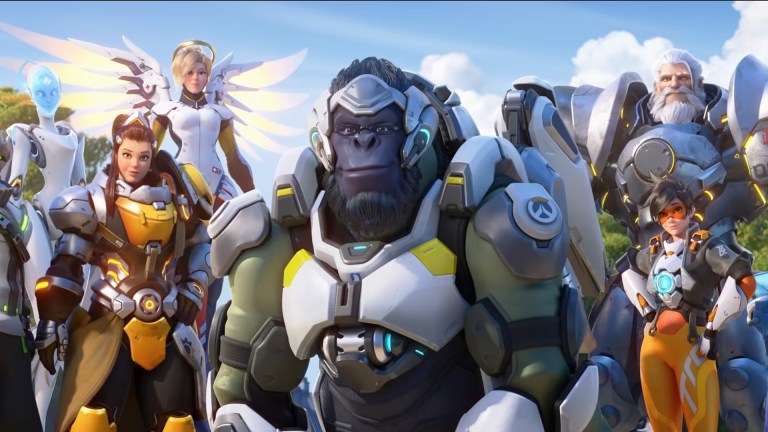Overwatch 2 Ranking System Explained: How to Unlock Competitive Mode
Competitive play is the heart of the Overwatch 2 experience, but before you can start working your way through the ranks, you need to overcome a different kind of challenge.

Activision Blizzard is currently under investigation following accusations of harassment, discrimination, and fostering a hostile work environment. You can read more about the investigation here.
Overwatch 2 features a ton of game modes, including Unranked, Arcade, and Training. If you want to really show off your skills, though, the game’s ranked mode is right for you. The problem is that many aspects of Overwatch 2‘s ranked mode (including how to unlock that mode in the first place) are surprisingly difficult to understand.
In Overwatch 2, the ranked mode, better known as “Competitive” mode, works similarly to how it functioned in the original Overwatch. Players of similar skill levels are assigned to teams and tasked with competing for points and glory. The better someone does in the game’s Competitive play options, the higher their rank climbs. The higher their rank climbs, the better players you get to team up with and face. Well…at least that’s the way things are supposed to work. It’s just as likely that you’ll soon discover even the upper echelons of Overwatch 2‘s ladder are filled with teammates of varying quality.
So while we can’t guarantee your journey through Overwatch 2‘s competitive ranks will be a smooth one, here are the basic things you need to know about the game’s ranked play systems.
Overwatch 2: How To Unlock Competitive Mode
In the original Overwatch, players couldn’t participate in Competitive Mode until they reached level 25 (out of 50). Since levels are no longer a thing in Overwatch 2, though, that requirement has been removed. Instead, players now have to overcome a different hurdle that, depending on luck, can either take no time at all or grind their progression to a halt.
According to the Overwatch 2 website, players can’t unlock Competitive Mode until they have won 50 Quick Play (i.e., Unranked) matches. Not play, mind you, but win. If a player teams up with decent, if not especially skilled, allies, they can breeze through that challenge relatively quickly. If not, they might be stuck in Unranked for an unreasonable amount of time.
Competitive Mode is one of many features Overwatch 2 locks behind a progression grind wall, along with pre-existing characters, in what Blizzard calls the “First Time User Experience” (FTUE). But while players can circumvent most of these limitations by teaming up with friends, Competitive Mode is the sole exception. Anyone who is new to Overwatch and wants to climb the ranks with their buddies and random players will have to earn that right. It’s not an ideal system, to say the least.
Overwatch 2’s Ranking System, Explained
For the most part, Overwatch 2‘s Competitive Mode is relatively similar to the competitive mode seen in the game’s predecessor. However, Blizzard inserted a few quality-of-life improvements to make the ranking ladder fairer in Overwatch 2. That doesn’t mean the competition players will face will go easy on them, though. It just means that a few of the game’s lingering annoyances have been smoothed out.
As with Overwatch 2‘s other game modes, Competitive play is split between attacking and defending rounds. The team that attacked one round defends during the next round, and vice versa. Every match continues until one team scores enough points by completing the given objective on a map. Unlike Overwatch 2’s other modes, though, individual ranks determine who players will fight alongside and against.
For Overwatch 2, Blizzard slightly changed how the ranking system works compared to the similar system in the original game. For reference, here is every ranking in Overwatch 2‘s Competitive mode in order of progression:
- Bronze
- Silver
- Gold
- Platinum
- Diamond
- Master
- Grandmaster
- Top 500
Again, those ranking should look familiar to anyone who grinded their way through the previous game’s ranking system. This time around, though, each ranking tier is broken up into divisions that go from 5 to 1. The lower a division, the higher a player’s skill within that tier. For instance, in order to make it to Gold Tier, Silver Tier players have to make it through Silver 5, Silver 4, Silver 3, Silver 2, and finally, Silver 1.
In order to keep fights fair, a player’s rank and current division determine what matches they can queue up for and who they play with/against. Specifically, Bronze, Silver, Gold, Platinum, and Diamond players can group up for rounds within two tiers of each other. For instance, Gold players can team up with Diamond players (and vice versa). Meanwhile, Master players are restricted to teaming up with others within one skill tier of themselves, while Grandmasters can only group up with players within three Divisions of their rank.
Originally, each Overwatch match’s outcome could alter a player’s ranking, but Blizzard changed the system for Overwatch 2. In order to actually change Tiers and Divisions, players have to win seven matches or lose/tie 20 matches (whichever comes first). While this method is slower, it is a touch fairer overall as a random crushing loss won’t mess up your current ranking as much as it used to.
If for some reason a player doesn’t do well during one season, the next season will partially reset all ranking progress and give them another shot at climbing the ladder. Because new seasons do not force you to start from the absolute bottom, though, the progress you make each season will carry over to new seasons (to some degree). The higher you rank in a season, the lower you’ll fall at the start of the next season when a new set of placement matches begin (if you fall at all). So get out there and start working your way through Overwatch 2‘s ranks if you want to eventually reach the top of the ladder!
